Animations
Viewing Information
Some of these movies require Adobe Flash Player for viewing. Download the plug-in here.
Viewing Online
View movie by clicking on its image.
Downloading (for use offline, not available for all videos)
Flash movies are downloadable via their linked images below. To download, right-click the image. For PC users, choose the option that says, "Save Target As..." and choose the location to save the file to on your hard drive. For Mac users, right-click the image and choose "Download Linked File" and the file will be saved to your Downloads folder.
Neuron Communication
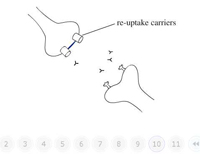 This animation can be navigated through a series of steps and illustrates how two nerve cells communicate with each other to transmit an impulse. See our Neuroscience Lessons on our Lessons page. (978kb)
This animation can be navigated through a series of steps and illustrates how two nerve cells communicate with each other to transmit an impulse. See our Neuroscience Lessons on our Lessons page. (978kb)
Reflex Arc
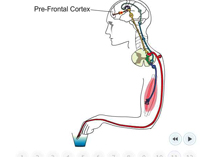 This animation can be navigated through a series of steps and illustrates how the nervous system responds to a stimulus. This includes the reflex arc as well as other voluntary movements and learning processes. See our Neuroscience lessons on our Lessons page. (978kb)
This animation can be navigated through a series of steps and illustrates how the nervous system responds to a stimulus. This includes the reflex arc as well as other voluntary movements and learning processes. See our Neuroscience lessons on our Lessons page. (978kb)
Stem Cells
The LSLC's first foray into the world of claymation, this video explains what it means to be pluripotent versus multipotent and describes stem cells could be used in cell replacement therapies. Complete with a sound track made by a local elementary school, this video is both fun and informative. See our Stem Cells lessons on our Lessons page. (Run Time = 5:25 Minutes)
Cholera: Pathogens, to be or not to be?
This video describes work done in the Dziejman Lab at the University of Rochester to understand the molecular differences between pathogenic and non-pathogenic cholera bacteria. See our Cholera lessons on our Lessons page (Run Time = 6:09 Minutes).
Cellular Respiration
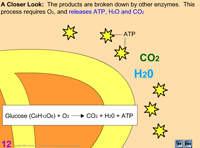 This animated slide show illustrates the basic steps of cellular respiration, both as an overview and as a closer look at what happens in the mitochondria. (Run Time = ~7 Minutes, 47.5kB)
This animated slide show illustrates the basic steps of cellular respiration, both as an overview and as a closer look at what happens in the mitochondria. (Run Time = ~7 Minutes, 47.5kB)
DNA and Genetic Disorders
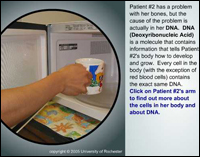 This interactive program takes students on a tour of cells and DNA. It illustrates how DNA is transcribed into RNA and the RNA is translated into protein, and how proteins fold in order to have a function. It then illustrates how a mutation in the DNA can lead to a non-functional protein. (Run Time = ~4 minutes, 4.8mb)
This interactive program takes students on a tour of cells and DNA. It illustrates how DNA is transcribed into RNA and the RNA is translated into protein, and how proteins fold in order to have a function. It then illustrates how a mutation in the DNA can lead to a non-functional protein. (Run Time = ~4 minutes, 4.8mb)
DNA to RNA to Protein - What does it all mean?
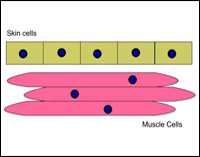 This narrated movie illustrates the process of gene expression, the transcription of DNA into RNA and the translation of RNA into proteins, as well as protein folding. It also illustrates how expressing different genes in different cells can lead to cells with different characteristics and functions. (Run Time = 2 Minutes, 273kb)
This narrated movie illustrates the process of gene expression, the transcription of DNA into RNA and the translation of RNA into proteins, as well as protein folding. It also illustrates how expressing different genes in different cells can lead to cells with different characteristics and functions. (Run Time = 2 Minutes, 273kb)
Electrophoresis—Separating by Length
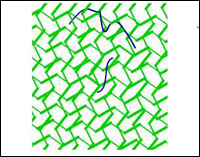 This movie illustrates how individual strands of DNA move through a gel during the process of electrophoresis, and how this can result in the separation of DNA fragments on the basis of length. The gel polymers are shown in green, and the DNA fragments are shown in blue. (Run Time = ~15 sec, 25kb)
This movie illustrates how individual strands of DNA move through a gel during the process of electrophoresis, and how this can result in the separation of DNA fragments on the basis of length. The gel polymers are shown in green, and the DNA fragments are shown in blue. (Run Time = ~15 sec, 25kb)
Electrophoresis—What's in a Band?
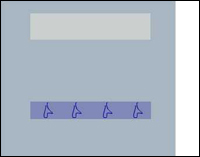 After seeing how individual strands of DNA move through a gel, this movie illustrates how many of those fragments can appear as a band of DNA on a gel. The well of a gel is shown in light blue. DNA fragments start in the well. When an electrical current (illustrated by the positive and negative poles at the top and bottom of the well) is applied, the DNA moves toward the positive pole. Groups of similarly sized fragments travel together through the gel, and are observed as a "band", which represents many similarly sized fragments. (Run Time = 15 sec, 27kb)
After seeing how individual strands of DNA move through a gel, this movie illustrates how many of those fragments can appear as a band of DNA on a gel. The well of a gel is shown in light blue. DNA fragments start in the well. When an electrical current (illustrated by the positive and negative poles at the top and bottom of the well) is applied, the DNA moves toward the positive pole. Groups of similarly sized fragments travel together through the gel, and are observed as a "band", which represents many similarly sized fragments. (Run Time = 15 sec, 27kb)
Photosynthesis
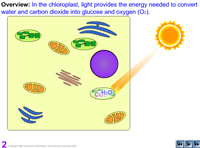 This animated slide show illustrates the basic steps of photosynthesis, both as an overview and as a closer look at what happens in the chloroplast. (Run Time = ~7 Minutes, 47.0kB)
This animated slide show illustrates the basic steps of photosynthesis, both as an overview and as a closer look at what happens in the chloroplast. (Run Time = ~7 Minutes, 47.0kB)
Polymerase Chain Reaction (PCR)—Virtual Lab
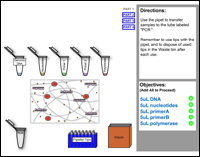 This narrated interactive program takes you through the process of setting up a polymerase chain reaction (PCR) and running PCR products on an aragose gel; illustrates the mechanism of polymerase chain reaction and aragose gel electrophoresis. (Run Time = ~6 minutes, 4.68MB)
This narrated interactive program takes you through the process of setting up a polymerase chain reaction (PCR) and running PCR products on an aragose gel; illustrates the mechanism of polymerase chain reaction and aragose gel electrophoresis. (Run Time = ~6 minutes, 4.68MB)
Protein Electrophoresis
 This narrated, interactive program illustrates how proteins can be separated on basis of length. Since proteins exists as folded structures, this program also illustrates how the structure of the protein is unfolded by STS prior to performing electrophoresis. (Run Time = ~3 minutes, 1.01MB)
This narrated, interactive program illustrates how proteins can be separated on basis of length. Since proteins exists as folded structures, this program also illustrates how the structure of the protein is unfolded by STS prior to performing electrophoresis. (Run Time = ~3 minutes, 1.01MB)
AIDS, HIV and tRNA
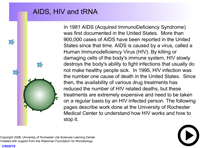 Adapted from a research paper published in 2001, written by Matthew Renda and others, this interactive paper describes an experiment that tests whether an altered tRNA can be used to stop Human Immunodeficiency Virus (HIV) from converting its single-stranded RNA into double-stranded DNA. This conversion is a necessary step for HIV to infect human cells.
Adapted from a research paper published in 2001, written by Matthew Renda and others, this interactive paper describes an experiment that tests whether an altered tRNA can be used to stop Human Immunodeficiency Virus (HIV) from converting its single-stranded RNA into double-stranded DNA. This conversion is a necessary step for HIV to infect human cells.
Teacher's guide to the interactive paper on AIDS, HIV and tRNA (including paper outline)
Color key for nucleotides in the interactive paper
AIDS, HIV and tRNA assessment questions and LO's for each section
Bacterial Homeostasis and Tooth Decay
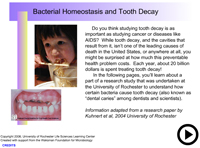 Adapted from a research paper published in 2004, written by Wendi Kuhnert and others, this research paper describes an experiment that addresses how a bacteria that causes tooth decay can survive at low pH.
Adapted from a research paper published in 2004, written by Wendi Kuhnert and others, this research paper describes an experiment that addresses how a bacteria that causes tooth decay can survive at low pH.
Teacher's guide to the interactive paper on Bacterial Homeostasis and Tooth Decay (including paper outline
Bacterial Homeostasis and Tooth Decay assessment questions and LO's for each section